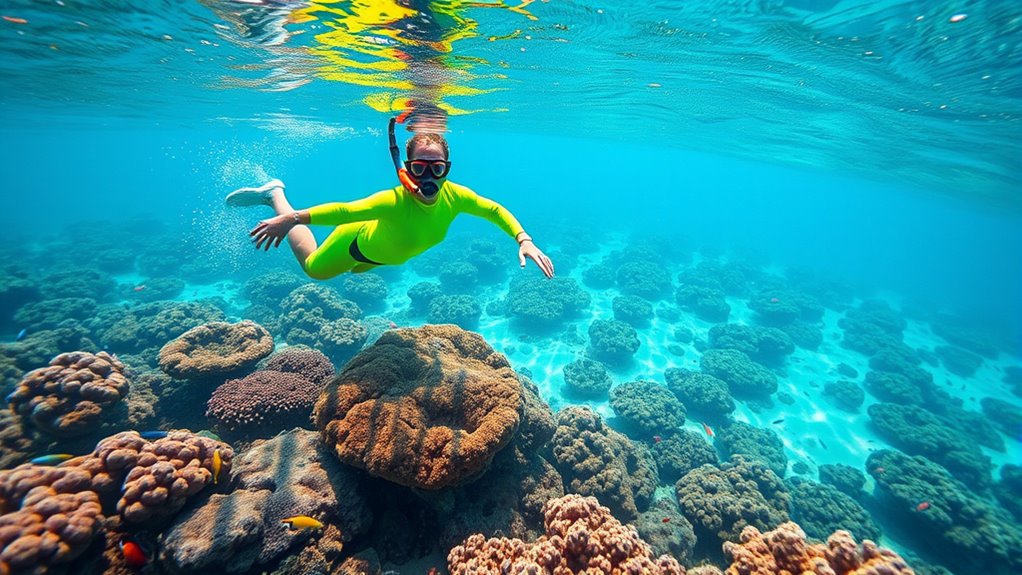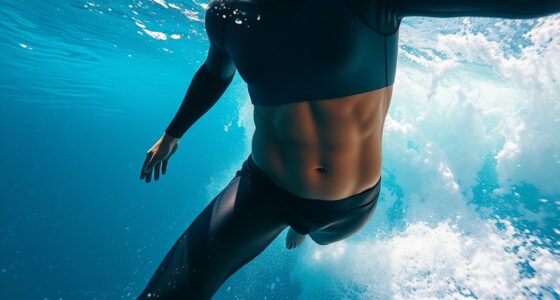For a safe snorkeling adventure, choose properly fitting gear, stay close to the shore, and never snorkel alone. Always check weather conditions and water safety beforehand, and use flotation devices if needed. Practice basic techniques and signals, protect your skin from the sun, stay hydrated, and share your plans with someone trustworthy. Keeping awareness of your limits and environment helps prevent accidents. If you want to know more tips, keep exploring these helpful guidelines.
Key Takeaways
- Use well-fitting, high-quality gear and test it before entering the water.
- Always snorkel with a buddy and maintain visual contact and clear communication.
- Check weather, water conditions, and local regulations before your trip.
- Respect marine life and avoid touching or disturbing animals and habitats.
- Stay within your skill limits, avoid strong currents, and use flotation devices for safety.
Choose the Right Snorkeling Gear
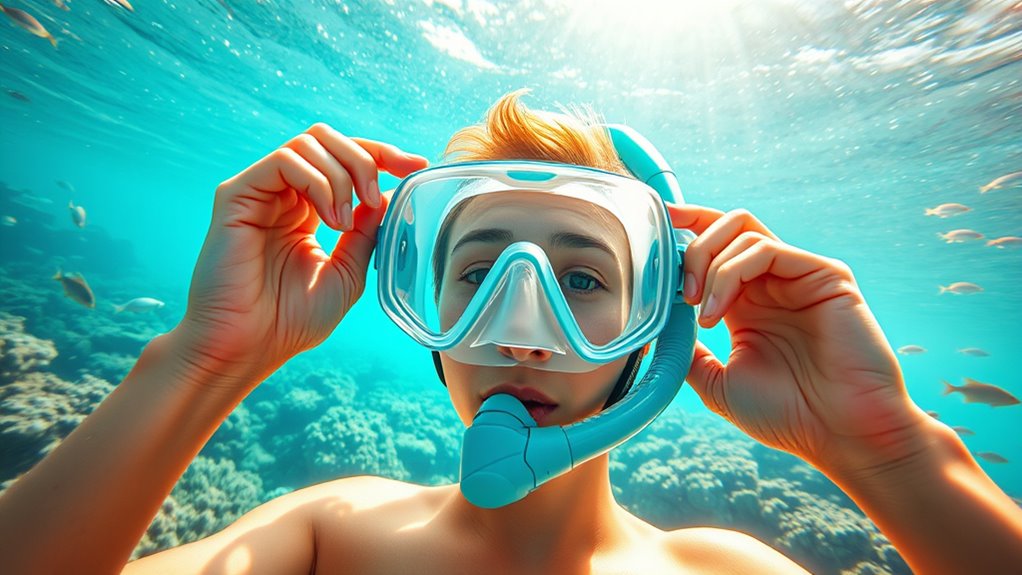
Choosing the right snorkeling gear is essential for a safe and enjoyable experience. Your mask’s fitting type matters because a snug, comfortable fit prevents leaks and water intrusion. Look for masks with adjustable straps and flexible skirts that mold to your face. When selecting fins, consider their material durability; sturdy, high-quality materials like silicone or rubber ensure they withstand frequent use and rough conditions. The snorkel should also fit well, with a dry-top design to prevent water from entering. Don’t compromise on comfort or quality—poor-fitting gear can cause discomfort or even safety hazards. Prioritize gear made from durable materials that can endure saltwater, sun, and wear. Properly fitting, high-quality gear sets the foundation for a confident, safe snorkeling adventure. Additionally, marine environment considerations like saltwater resistance and eco-friendly materials can further enhance your experience and minimize impact on marine ecosystems. Ensuring your gear is compatible with energetic alignment can also promote a more relaxed and harmonious snorkeling experience. Selecting gear that offers proper fit and comfort is crucial, as it directly impacts your ability to move freely and respond quickly in case of emergencies.
Check Weather and Water Conditions
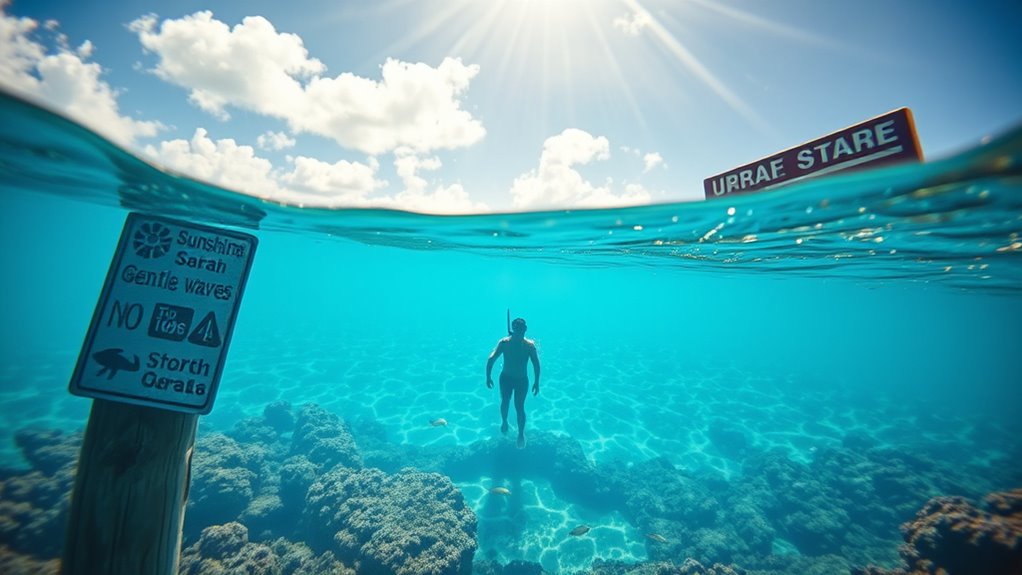
Before heading out for your snorkeling trip, it’s essential to check the weather and water conditions to guarantee a safe experience. Good weather awareness helps you avoid dangerous currents, high waves, or storms that could compromise marine safety. Always review local forecasts and water condition reports before setting out. Use the table below to understand key factors:
| Weather Factor | Impact on Marine Safety |
|---|---|
| Wind Speed | Strong winds create rough waters |
| Tides | Affect water clarity and currents |
| Storms | Increase risk of sudden hazards |
Monitoring these factors ensures you’re prepared and minimizes risk, making your snorkeling adventure both safe and enjoyable. Additionally, understanding marine environment conditions can help you better anticipate and respond to potential hazards. Being aware of water temperature can also influence your safety and comfort during your outing. Staying informed about local regulations can additionally prevent legal issues and promote eco-friendly practices during your trip. Awareness of vital safety information is crucial for a responsible snorkeling experience.
Never Snorkel Alone
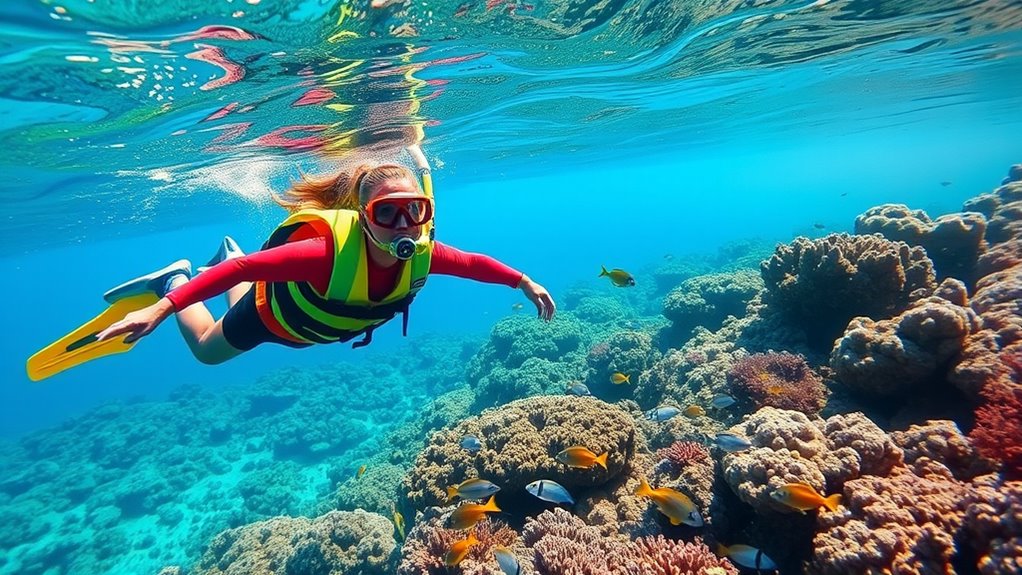
Always share your plans with someone before you start snorkeling, so they know where you’ll be. Keep your contact devices accessible in case you need help quickly. Stay within sight of your buddy or group to guarantee everyone’s safety at all times. Additionally, consider using waterproof communication devices to stay connected even when submerged or in challenging conditions. Remember, proper safety protocols are essential to ensure a fun and secure experience. Incorporating AI-powered safety tools, such as real-time location sharing, can further enhance your safety during snorkeling adventures. Understanding the importance of contrast ratio in visual clarity can help you better evaluate the safety gear and signage around your snorkeling area, ensuring clear visibility in varying light conditions. Moreover, being aware of vegetable juice benefits can help you stay energized and hydrated during your outdoor activities.
Share Your Plans
Have you ever wondered what could happen if you snorkel alone? Sharing your plans is essential for proper snorkeling safety and adventure planning. When you inform someone about your location, expected return time, and route, you create a safety net that can be lifesaving. It also encourages responsible behavior and helps others assist if you’re in trouble. Regularly reviewing and adjusting your plans based on your personal goal tracking can enhance your safety measures and preparedness. Remember to:
- Clearly communicate your snorkeling spot and schedule
- Share your plans with a trusted friend or family member
- Check in before and after your trip
- Have a backup plan in case of emergencies
- Carry essential contact information with you
- Be aware of skincare considerations that can affect your comfort and safety during water activities.
- Stay informed about local water conditions and potential hazards to ensure a safe experience. Additionally, understanding home essentials like safety gear can further improve your preparedness, especially when considering skin protection to prevent sun damage during prolonged exposure.
Keep Contact Devices
Carrying reliable contact devices is essential when snorkeling, especially if you’re alone. Waterproof communication tools ensure you can stay in touch or call for help if needed. Always carry emergency contact devices like waterproof radios or signaling devices that work underwater and on the surface. These devices help you stay connected to guides, friends, or emergency services, reducing risks if you encounter trouble. Make sure your contact devices are fully charged, and familiarize yourself with their operation before entering the water. Avoid relying solely on your phone, as it may not be waterproof or function properly when submerged. Regular maintenance and testing of your communication equipment can maximize safety and ensure they function properly when needed. Investing in specialized aquatic communication devices can further enhance your safety and connectivity during your snorkeling adventures. Additionally, understanding local safety guidelines can further prepare you for potential emergencies and ensure a safer experience. Staying prepared with backup communication options can also prevent situations where you might be unable to contact help.
Stay Within Sight
- Keep your partner in your line of sight at all times
- Agree on signals for communication underwater
- Stick to designated safe zones
- Be aware of your surroundings and currents
- Avoid crowded or unclear water conditions
- Consider using essential oils like lavender or peppermint to promote relaxation and focus before your trip.
Stay Close to the Shore and Within Your Limits
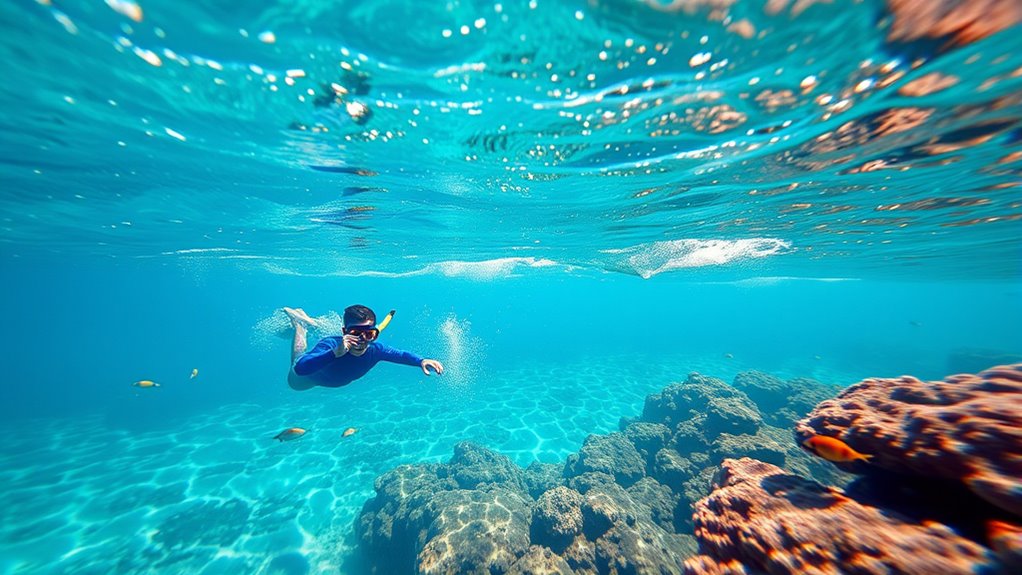
Staying close to the shore helps you keep track of your location and avoid getting lost. Know your limits so you don’t push beyond your comfort zone or skill level. Using visible landmarks makes it easier to stay aware of your position and return safely.
Know Your Boundaries
Understanding your boundaries is essential for a safe and enjoyable snorkeling experience. By practicing boundary awareness, you prevent yourself from venturing into risky situations and help ensure you stay within your comfort zone. Always assess the environment and your physical condition before exploring further. Recognize signs of fatigue or disorientation early to avoid accidents. Remember, staying close to the shore allows quick access to help if needed. Trust your instincts and don’t push beyond your limits. Keep these in mind:
- Know your swimming ability and comfort level
- Avoid strong currents or rough waters
- Don’t ignore fatigue or difficulty breathing
- Restrict your distance based on your skills
- Regularly evaluate your surroundings and personal limits
Use Visible Landmarks
Using visible landmarks helps you stay within your comfort zone and avoid unnecessary risks. Landmark identification is a key navigation technique that keeps you oriented and confident during your snorkel. Choose prominent features like buoys, rocks, or specific coral formations to guide your path and monitor your distance from the shore. Keep a mental note of these landmarks and frequently check your surroundings to assure you’re staying within safe limits. If you drift or feel unsure, use your landmarks to reorient yourself quickly. Staying close to the shore minimizes the chance of getting lost or encountering strong currents. By actively using landmarks, you enhance your safety and enjoy your snorkeling adventure with peace of mind.
Use a Floatation Device if Needed
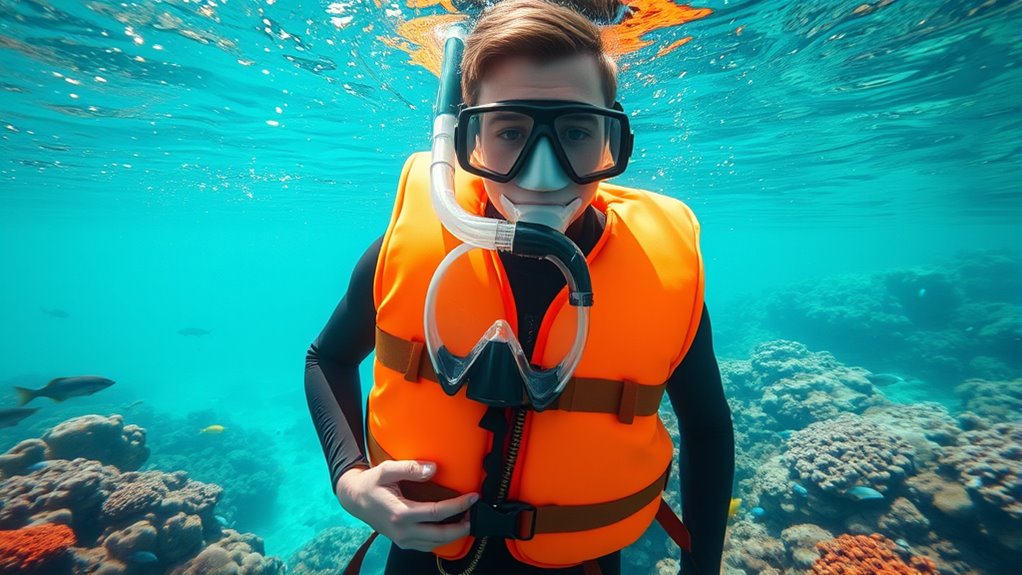
If you’re new to snorkeling or feeling unsure, a flotation device can provide essential support and boost your confidence in the water. Using floatation devices, like safety vests, guarantees you stay afloat and reduces fatigue. They’re especially helpful if you tire easily or are not a strong swimmer. Wearing a safety vest can also help you conserve energy and focus on enjoying the sights around you. Remember, a proper floatation device offers peace of mind, allowing you to relax and breathe comfortably.
- Provides stability in rough waters
- Helps conserve energy during long swims
- Boosts confidence for beginners
- Keeps you visible to others
- Adds an extra layer of safety in unfamiliar environments
Be Aware of Marine Life and Respect Their Habitat
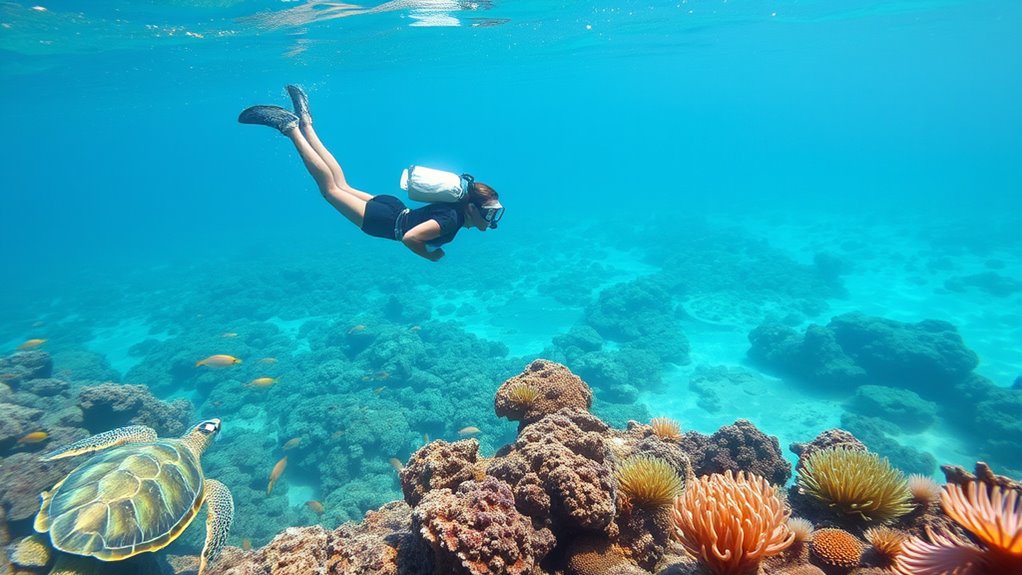
As you explore underwater environments, it’s important to be mindful of marine life and their habitats. Respectful behavior ensures marine conservation and habitat preservation for future generations. Avoid touching or disturbing animals, as this can cause stress or harm. Keep a safe distance and observe quietly. Remember, fragile ecosystems can be easily damaged by careless actions. To highlight this, consider the importance of protected areas:
| Respect Marine Life | Avoid Damage | Support Conservation |
|---|---|---|
| Don’t touch or chase animals | Do not collect shells or corals | Follow guidelines and signage |
| Maintain a safe distance | Avoid kicking up sediment | Participate in reef cleanup efforts |
| Observe quietly | Don’t feed marine creatures | Support marine protected areas |
Learn Basic Snorkeling Skills and Signals
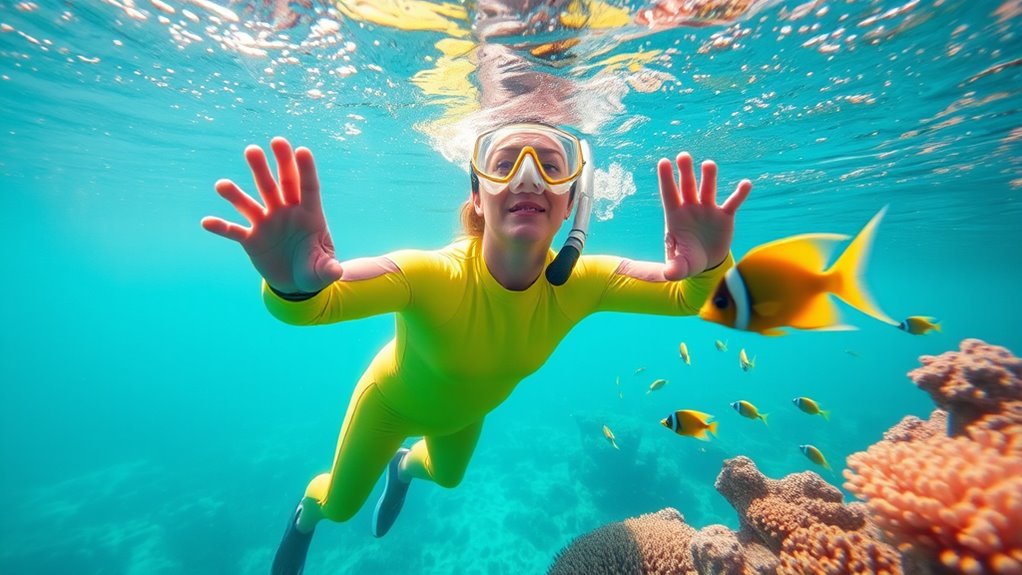
To snorkel safely and confidently, mastering basic skills and signals before venturing into the water is vital. You should practice effective breathing techniques to stay calm and conserve energy. Learning and using hand signals allows you to communicate clearly with your snorkeling buddy, especially when verbal communication isn’t possible. Knowing how to clear your mask and equalize your ears prevents discomfort and panic. Developing proper fin techniques helps you move smoothly and avoid fatigue. Remember to signal if you need help or feel uneasy, ensuring safety is always prioritized.
- Practice clear hand signals for communication
- Master relaxed breathing techniques
- Learn how to clear water from your mask
- Develop efficient fin movements
- Always signal distress or discomfort immediately
Protect Your Skin With Sunscreen and Appropriate Clothing
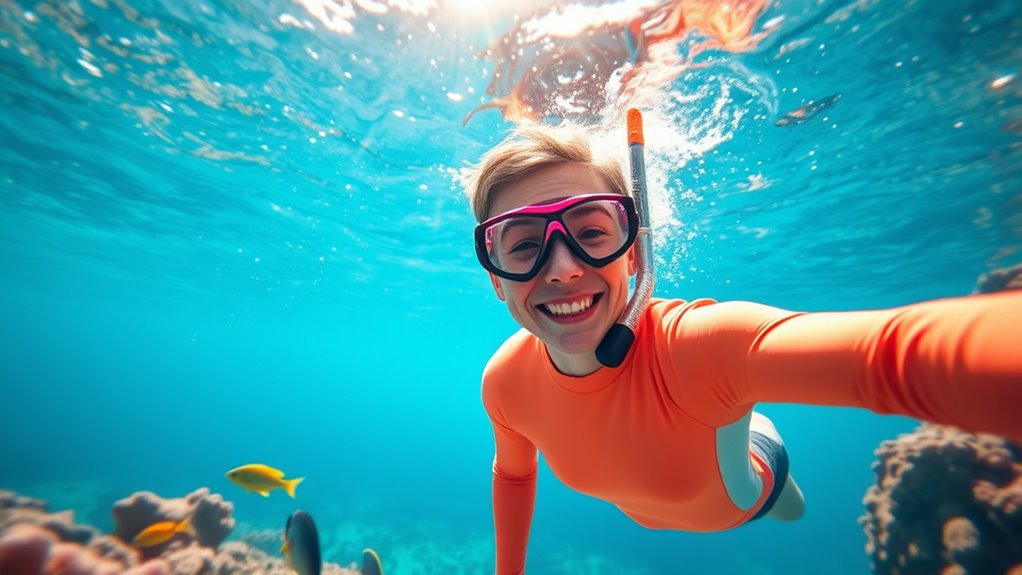
Protecting your skin from harmful sun exposure is essential when snorkeling, especially since you’re often in open water where UV rays can be intense. To guarantee proper sun protection, apply a broad-spectrum sunscreen with at least SPF 30 generously on all exposed skin, and reapply every two hours or after swimming. Wearing appropriate clothing, like a lightweight rash guard or long-sleeved swim shirt, adds an extra layer of defense against UV rays while keeping you cool. A wide-brim hat and UV-protective sunglasses can also shield your face and eyes. Remember, the sun’s rays can reflect off the water, increasing exposure. By combining sun protection strategies with appropriate clothing, you markedly reduce your risk of sunburn and skin damage during your snorkeling adventure.
Stay Hydrated and Avoid Alcohol
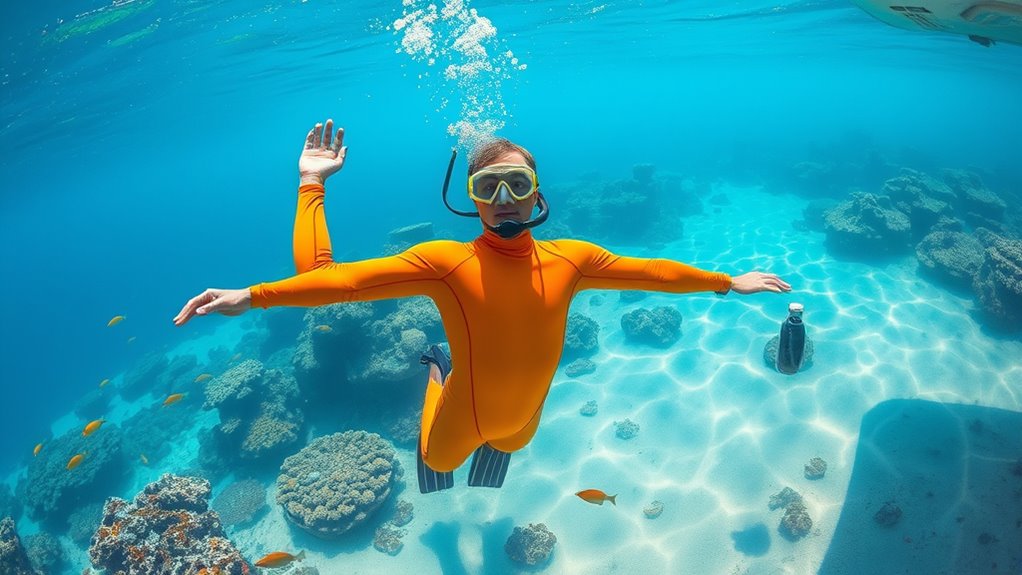
Staying properly hydrated is essential for a safe and enjoyable snorkeling experience, especially in warm, sunny conditions. Dehydration can impair your judgment, reduce stamina, and increase the risk of heat exhaustion. Follow hydration tips like drinking water regularly before and during your trip, and avoid beverages that can dehydrate you. Alcohol avoidance is vital, as alcohol impairs your ability to recognize signs of dehydration, dizziness, or fatigue. Remember, alcohol can also lower your body temperature and increase the risk of accidents. To stay safe, carry a water bottle, sip fluids often, and skip alcohol entirely while snorkeling. Being well-hydrated keeps your body functioning at its best, allowing you to focus on the beauty beneath the surface.
Plan Your Snorkeling Trip and Share Your Plans
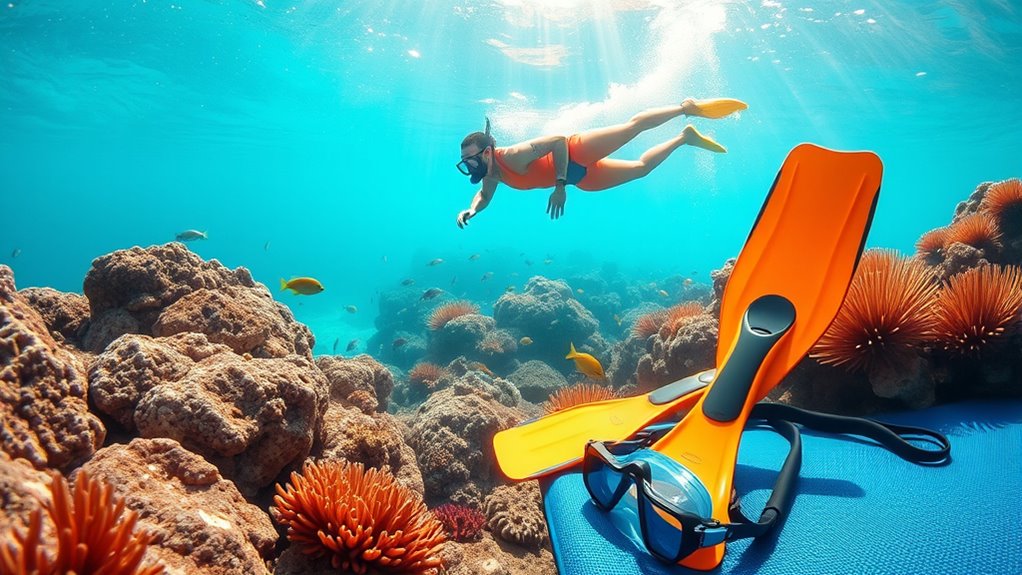
Before you head out, make sure to share your plans with someone you trust, so they know where you’ll be. Always check the weather forecast to avoid unexpected storms or rough waters. Being prepared and transparent keeps your trip safe and enjoyable.
Share It With Others
Planning your snorkeling trip carefully and sharing your plans with others is essential for safety and peace of mind. When you do this, you help guarantee someone knows your whereabouts, making it easier to get help if needed. Communicate your plans clearly, including your expected return time and location. Respect snorkeling etiquette by minimizing environmental impact and avoiding disturbance to marine life. Sharing your plans promotes marine conservation, as responsible snorkelers help protect fragile ecosystems. Consider these key points:
- Inform a trusted friend or family member about your schedule
- Share your plans on social media or with local authorities
- Respect local regulations and protected areas
- Educate yourself on marine conservation efforts
- Prepare emergency contacts and safety procedures
Being open about your plans fosters safety, encourages responsible snorkeling, and supports marine conservation efforts.
Check Weather Conditions
Checking the weather conditions before your snorkeling trip is crucial to guarantee safety and an enjoyable experience. Weather patterns can change quickly, affecting water visibility and safety. Always review forecast reports and avoid days with storms or high winds. Tide schedules are equally important; low tides can expose sharp rocks or reduce reef access, while high tides might create stronger currents. Plan your trip during calm weather and favorable tide conditions to ensure better visibility and safer swimming. Keep an eye on the forecast leading up to your outing, and consider local advisories. Being aware of weather patterns and tide schedules helps you avoid dangerous situations and makes your snorkeling adventure more enjoyable. Safety starts with good planning—so check the weather before you plunge in.
Frequently Asked Questions
What Should I Do if I Encounter Aggressive Marine Animals?
If you encounter aggressive marine animals, stay calm and avoid sudden movements. Pay attention to marine animal behavior, recognizing signs of agitation. Slowly back away without turning your back or splashing, which could escalate the situation. Use safety equipment selection wisely, like wearing protective gear if needed. Keep a safe distance, and if the animal approaches, remain still and assertive. Seek help from a guide or fellow snorkelers if needed.
How Can I Prevent Ear Equalization Issues While Snorkeling?
You might think ear popping during snorkeling is unavoidable, but it’s often caused by pressure changes. To prevent ear equalization issues, try gentle mask adjustments and yawning or swallowing to open your Eustachian tubes. If you feel discomfort, stop and ascend slightly to relieve pressure. Investigating these simple techniques can make your experience smoother, helping you stay comfortable and enjoy your underwater adventure without worrying about painful ear issues.
Are There Specific Safety Tips for Snorkeling in Strong Currents?
When snorkeling in strong currents, you need to prioritize currents awareness to stay safe. Always check weather and water conditions before entering, and stay close to the shore or a designated safe zone. Use reliable safety equipment like a snorkel vest for buoyancy and a dive flag to signal your position. Stay calm, conserve energy, and avoid fighting the current—let it carry you while you guide yourself back safely.
What Emergency Signals Should I Use if I Need Help?
When you’re underwater, clarity matters—so knowing your emergency signals is vital. If you need help, use clear distress calls like waving your arm above your head or making an ‘X’ with your arms to signal trouble. These emergency signals stand out like a lighthouse in a storm. Stay calm, stay visible, and remember, quick, unmistakable gestures guarantee rescuers know you’re in need and can respond swiftly.
How Do I Identify Dangerous Marine Species Before Approaching?
To identify dangerous marine species before approaching, pay attention to their marine habitat and species behavior. Look for signs like aggressive postures, bright warning colors, or unusual movements. Stay cautious around areas known for hazardous creatures, such as jellyfish or lionfish. Always observe from a safe distance, and avoid touching or disturbing marine life. Your awareness of habitat and behavior helps prevent accidents and guarantees a safer snorkeling experience.
Conclusion
Think of your snorkeling adventure as steering a delicate ship through tranquil waters. With the right gear, careful planning, and awareness, you become the captain of your safety. Respect the currents and listen to your instincts, guiding you like a lighthouse through the unknown. By staying prepared and cautious, you’ll navigate these underwater waters with confidence, turning every immerse into a cherished voyage—safe, smooth, and truly unforgettable.

